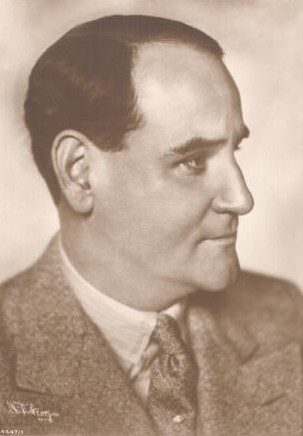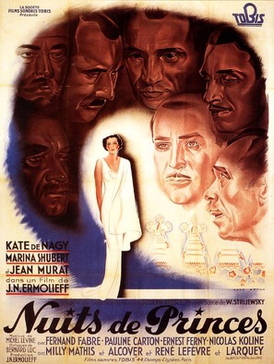Related Research Articles

Ivan Ilyich Mozzhukhin, usually billed using the French transliteration Ivan Mosjoukine, was a Russian silent film actor.

Albert S. Rogell was an American film director. Rogell directed more than a hundred movies between 1921 and 1958. He was known for an aggressive directing style, shouting at his actors and crew.

The Battle of Sculeni was fought on 29 June 1821 in Sculeni, Moldavia between Ottoman forces and the Greek revolutionary forces raised by the Filiki Eteria led by Prince George Katakouzenos. The battle came about as the result of Ottoman reprisals for Alexander Ypsilantis' expedition in the two Danubian Principalities, and followed in the aftermath of the Battle of Dragashani. When the Ottomans crossed the Bahlui River in Iaşi on 25 June 1821, Lieutenant Catakouzenos and his forces, originally stationed on the Russian frontier, crossed the Prut River.
Harold Shumate was an American screenwriter. He wrote for 100 films between 1917 and 1954. He was born in Austin, Texas and died in Ventura County, California.

Robert Frazer was an American actor who appeared in some 224 shorts and films from the 1910s until his death. He began in films with the Eclair company which released through Universal Pictures.
Alexander Alexandrovich Murski was a Saint Petersburg, Russian-born German actor. Murski died in 1943 in Toulouse, Haute-Garonne, France.

Hans Adalbert Schlettow was a German film actor. Schlettow appeared in around a hundred and sixty films during his career, the majority during the silent era. Among his best-known film roles was Hagen von Tronje in Fritz Lang's film classic Die Nibelungen (1924). In 1929 he starred in the British director Anthony Asquith's film A Cottage on Dartmoor.
Gregor Rabinovitch was a Ukrainian-born film producer who worked for many years in the German film industry. He emigrated to France from the Soviet Union in the early 1920s. After working for a time in Germany, he left following the Nazi takeover of power in 1933, and spent a number of years in France and the United States. He later returned and died in Munich in 1953.

René Guissart was a French film director and cinematographer. During the 1920s and 1930s he worked as cinematographer on numerous British films, many of them for British International Pictures. He also worked on MGM's 1925 epic Ben-Hur. From 1931 Guissart began directing and had made twenty eight films by 1939.

Alexandre Volkoff was a Russian actor, screenwriter and film director. He established his film career in Russia and was one of a significant number of film artists who fled the country following the Bolshevik takeover.
Joseph N. Ermolieff (1889–1962) was a Russian-born film producer. Ermolieff was a prominent figure in early Russian cinema during the Imperial era, owning large studios in Yalta and Moscow. He fled to France following the Russian Revolution and became an established producer there, founding the company Films Albatros. As well as Paris he also worked at the Emelka Studios in Munich. In 1936 he enjoyed a major international success with The Czar's Courier, and he moved to the United States the following year planning to remake the film in English. He settled in America and became a citizen in 1942, but struggled to establish himself in Hollywood despite producing occasional films such as Outpost in Morocco (1949) and Fort Algiers (1953). In 1944 he produced a Mexican version of Michael Strogoff (1944).
Fédote Bourgasoff was a Russian Empire-born French cinematographer.
Nikolai Toporkoff (1885–1965) was a Russian Empire-born French cinematographer. Toporkoff fled his homeland following the 1917 Russian Revolution, moving to France where he shot around seventy films including the 1927 historical The Loves of Casanova.

The Patriot is a 1938 French historical drama film directed by Maurice Tourneur and starring Harry Baur, Pierre Renoir and Suzy Prim. The film was based on a novel by Alfred Neumann which had previously been turned into a 1928 American silent film The Patriot starring Emil Jannings. It was made by the French subsidiary of the German company Tobis Film. The sets were designed by the Russian-born art director Alexandre Lochakoff.
Films Albatros was a French film production company established in 1922. It was formed by a group of White Russian exiles who had been forced to flee following the 1917 Russian Revolution and subsequent Russian Civil War. Initially, the firm's personnel consisted mainly of Russian exiles, but over time, French actors and directors were employed by the company. Its operations continued until the late 1930s.

Le Lion des Mogols(The Lion of the Moguls) is a 1924 French drama film directed by Jean Epstein. It is the first film that he directed for the Films Albatros production company.

After Midnight is a 1938 French-German drama film directed by Carl Hoffmann and starring Gina Falckenberg, Peter Voß and René Deltgen. It was shot as a German-language version of the French film Nights of Princes, produced as a co-production between the French subsidiary of Tobis Film and the producer Joseph N. Ermolieff. Such multiple-language versions were common during the decade. Both films were based on the 1927 novel Nights of Princes by Joseph Kessel.

Nights of Princes is a 1938 French-German drama film directed by Vladimir Strizhevsky and starring Käthe von Nagy, Marina Koshetz and Jean Murat. It is based on a 1927 novel of the same title by Joseph Kessel. An earlier adaptation Nights of Princes had been made by Marcel L'Herbier in 1930.
Nights of Princes is a 1930 French drama film directed by Marcel L'Herbier and starring Gina Manès, Jaque Catelain and Harry Nestor. It is an adaptation of the 1927 novel of the same title by Joseph Kessel. The story was remade as a 1938 film directed by Vladimir Strizhevsky.

White Nights in Saint Petersburg is a 1938 French drama film directed by Jean Dréville and starring Gaby Morlay, Jean Yonnel and Pierre Renoir. It is an adaptation of the 1889 novella The Kreutzer Sonata by Leo Tolstoy. It is sometimes known by this title, and should not be confused with the 1937 German film The Kreutzer Sonata directed by Veit Harlan. The film's sets were designed by the art directors Lucien Carré, Alexandre Lochakoff and Vladimir Meingard while the costume design was overseen by Boris Bilinsky.
References
- ↑ Phillips p.39